The Magnificent Seven
- Topics: Article, Nutrition, Nutrition Basics, Vitamins & Minerals
Ever wonder why some minerals (such as copper, zinc, iron, and selenium) are referred to as “trace minerals” while other minerals (such as calcium and phosphorus) are not? According to some nutrition texts, the term “trace” was originally used for minerals required in amounts too small to measure. So, old nutritional guidelines might recommend a “trace” of copper or zinc, because the exact requirement was unknown. Because it was so difficult to measure trace minerals, research on these elements lagged behind research on other essential nutrients. Fortunately, modern labs can measure most of the trace minerals (iodine and selenium are still difficult), so knowledge in this important area is increasing.
Today, many nutritionists think of trace minerals as those required by horses at less than a gram per day. In 1989, the National Research Council’s Subcommittee on Horse Nutrition made die-tary recommendations for seven trace minerals–iron, cobalt, copper, zinc, iodine, selenium, and manganese. Each trace mineral is involved in at least one specific biological process important to life.
Iron is a part of hemoglobin, the compound in blood that transports oxygen. It is also important in the enzyme systems that produce adenosine triphosphate (ATP, the body’s energy currency that drives muscle contraction) during exercise.
Cobalt is important for the synthesis of vitamin B12, which is produced by microbes in the horse’s large intestine, and once absorbed is used for red blood cell formation. Cobalt deficiencies have not been observed in horses
Create a free account with TheHorse.com to view this content.
TheHorse.com is home to thousands of free articles about horse health care. In order to access some of our exclusive free content, you must be signed into TheHorse.com.
Start your free account today!
Already have an account?
and continue reading.

Written by:
Laurie Lawrence, PhD (equine nutrition)
Related Articles
Stay on top of the most recent Horse Health news with















